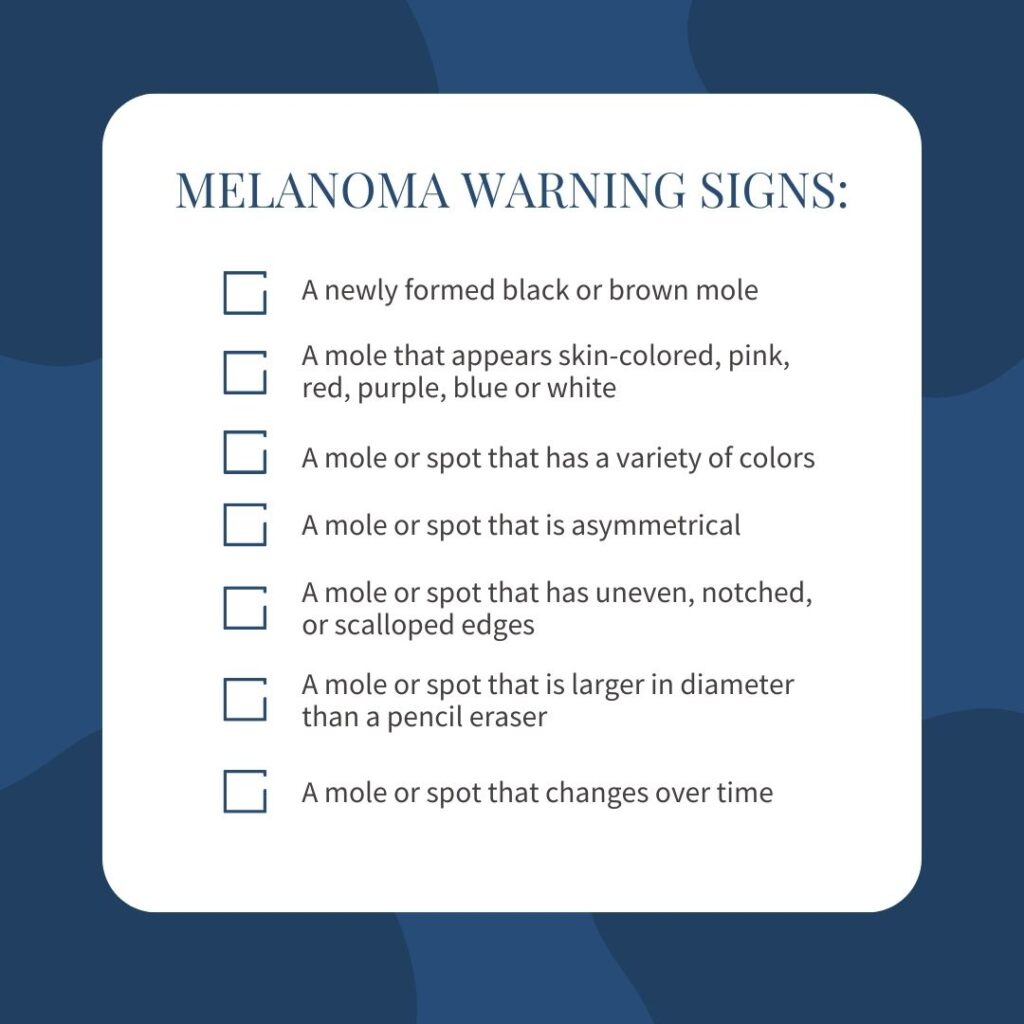Skin Cancer & Melanoma
Skin cancer is a common and potentially serious condition caused by the uncontrolled growth of abnormal skin cells. It is essential to protect your skin from harmful UV rays and regularly check it for any unusual changes or growths.
Basal Cell Carcinoma Squamous Cell Carcinoma Actinic Keratosis Melanoma
Skin Cancer in the US
The most common type of cancer in the United States is skin cancer. It occurs when skin cells are damaged due to overexposure to ultraviolet radiation from sunlight or tanning beds. The main types of skin cancer include Basal Cell Carcinoma (BCC), Squamous Cell Carcinoma (SCC), Actinic Keratosis (AK), and Melanoma. Fortunately, with early detection and proper treatment, most forms of skin cancer can be cured. Below you will find the signs and symptoms of skin cancer and information on how a skin cancer screen can save your life.
Skin Cancer by the Numbers
In the United States, more than
By the age of 70
Board-Certified Providers
All Our Providers are Board-Certified and State-Licensed Medical Professionals.
Unmatched Expertise
Our Providers Have Years of Experience Diagnosing and Treating Skin Conditions.
Comprehensive Care
We Provide Medical Dermatology, Cosmetic Dermatology, and Aesthetic Services.
Qualified
Staff
Our Staff Is Ready to Help You and Your Family With All of Your Dermatological Needs.
Expert Dermatology Care for the Entire Family
Signs and Symptoms of Skin Cancer

Skin cancer affects individuals of all genders and races. Its symptoms vary based on the type of cancer that is present. Here is a brief overview of the signs and symptoms you can expect from each type of skin cancer:
- Basal Cell Carcinoma (BCC): BCC patients often notice a translucent, red, pink, or shiny bump, pink lesions with raised borders and a crusty center, a raised reddish patch of crusty or itchy skin, or a yellow, white, or waxy area with a border that is poorly defined and gives the appearance of a scar.
- Squamous Cell Carcinoma (SCC): An open sore that persists for weeks, a raised growth with a rough surface and an indented center, and scaly red patches with irregular borders are all signs of SCC.
- Actinic Keratosis (AK): Symptoms of AK include a dry, rough, or scaly patch of skin that is less than 1 inch in diameter, burning or itching in the affected area, a flat or slightly raised bump on the top layer of skin, a hard surface that resembles a wart, and pink, red, brown, or flesh-colored skin.
- Melanoma: Melanoma patients are likely to find a mole that bleeds or changes in size or color, a large brown spot with darker speckles, a tiny lesion with an irregular border, and portions that are blue, white, or red, dark lesions on the toes, fingertips, palms, soles, nose, or other body parts, or an open sore that continues to persist.
Melanoma
Melanoma is a serious form of skin cancer most often caused by exposure to ultraviolet radiation from tanning beds or the sun. Melanoma grows when damage to skin cells, such as from ultraviolet radiation, triggers mutations that cause skin cells to begin rapidly multiplying into malignant tumors in a layer of the skin known as the basal layer. On the skin, melanomas tend to take on the appearance of a mole. Read on to learn the signs and treatment of melanoma.
When caught early, melanoma is likely curable. However, if left untreated, melanoma can result in death. In the United States alone, it is estimated that melanoma is responsible for 10,130 deaths annually. If you suspect you may be suffering from skin cancer, such as melanoma, make an appointment to be evaluated by a professional at Blue Ridge Dermatology today.
Types of Melanoma
There are 4 main types of melanoma. The first 3 types listed begin in the top layers of the skin and have the ability to become invasive as they progress. The 4th type is invasive from the start and the most serious form, found in 10 to 15 percent of melanoma cases.
- Superficial Spreading Melanoma: The most common form of melanoma, which spreads across the skin before penetrating more deeply.
- Lentigo Maligna: Most commonly in the elderly, this form of melanoma is similar to the superficial spreading melanoma.
- Acral Lentiginous Melanoma: Most often found under nails or on the soles of feet or palms of hands, this form of melanoma is most common in African-Americans and Asians.
- Nodular Melanoma: This is the most aggressive form of melanoma, and it is already invasive by the time of diagnosis.
Although melanoma is not the most common form of skin cancer, it has the highest mortality rate. Therefore, it is essential to check your skin regularly and seek medical attention when you see something suspicious. The appearance of melanoma can differ from person to person but below are warning signs that you should be aware of.

Expert Dermatology Care for the Entire Family

Melanoma Treatment
In order to treat melanoma, the doctors at Blue Ridge Dermatology will first remove the infected mole or area. This is commonly done by surgical excision in the office. Our doctors will outline the melanoma with a pen, including what is known as a “safety margin.” Local anesthesia will be used for pain management, and our doctors will take extreme care to only remove the necessary amount of tissue while still ensuring all damaged cells are removed.
Following the procedure, the “safety margin” will be evaluated by the lab to make sure the skin cancer has been completely removed. If needed, surgery will be completed a second time.
Skin Cancer Screening
Early detection of skin cancer greatly increases the likelihood of successful treatment and survival. In order to detect skin cancer early, the dermatologists at Blue Ridge Dermatology recommend annual skin cancer screenings. A skin cancer screening involves a comprehensive full body examination of your skin to inspect any areas of concern or for atypical lesions, growths, or changing moles. In most cases, a skin cancer screen only lasts ten minutes. However, if a questionable mole is found, the exam may take longer. If needed, a biopsy will be performed.
If skin cancer is detected, a dermatologist will discuss the next steps and treatment options available for your specific type and stage of skin cancer.
Contact Blue Ridge Dermatology Today
To ensure that your skin is healthy and cancer free, schedule an appointment at Blue Ridge Dermatology for your annual skin cancer screen. At Blue Ridge Dermatology in Raleigh and Cary, we provide each and every patient that enters our office with personalized, compassionate, and quality care. We are dedicated to helping you keep your skin in tip-top condition so that you can live a long, healthy life with beautiful skin.
Subscribe To Our Newsletter
Stay in touch with us to get latest news and special offers.
Raleigh
4225 Macon Pond Rd, Suite 300, Raleigh, NC 27607
Cary
1110 SE Cary Pkwy, Suite 100, Cary, NC 27518

